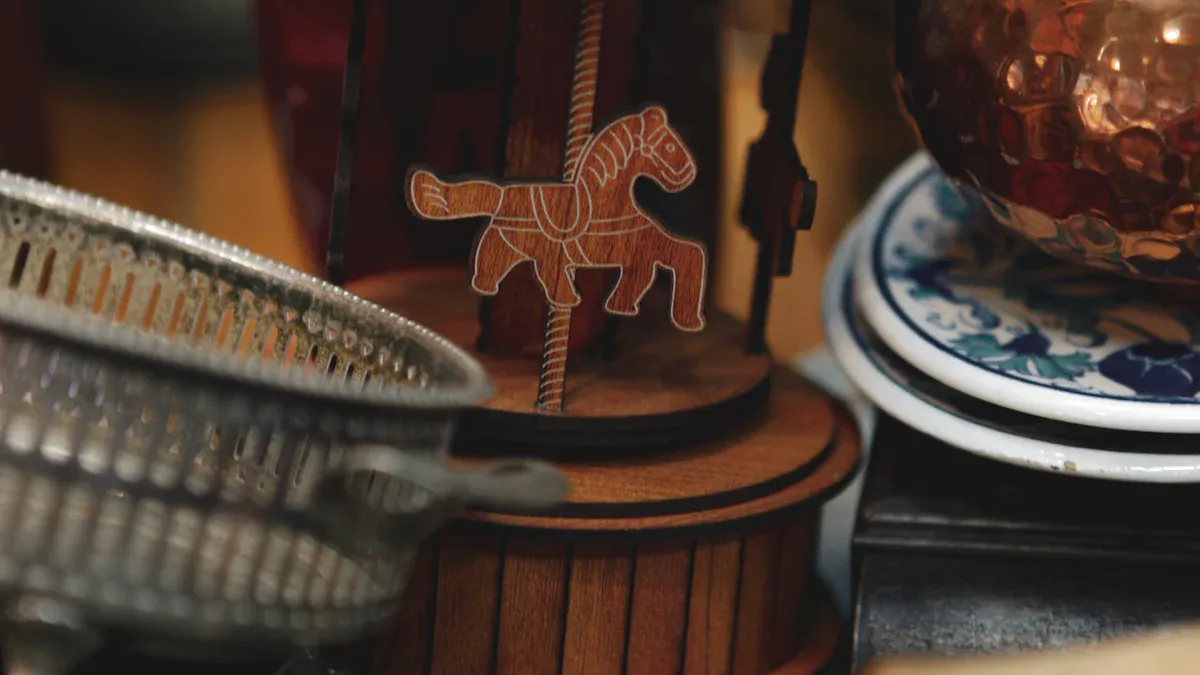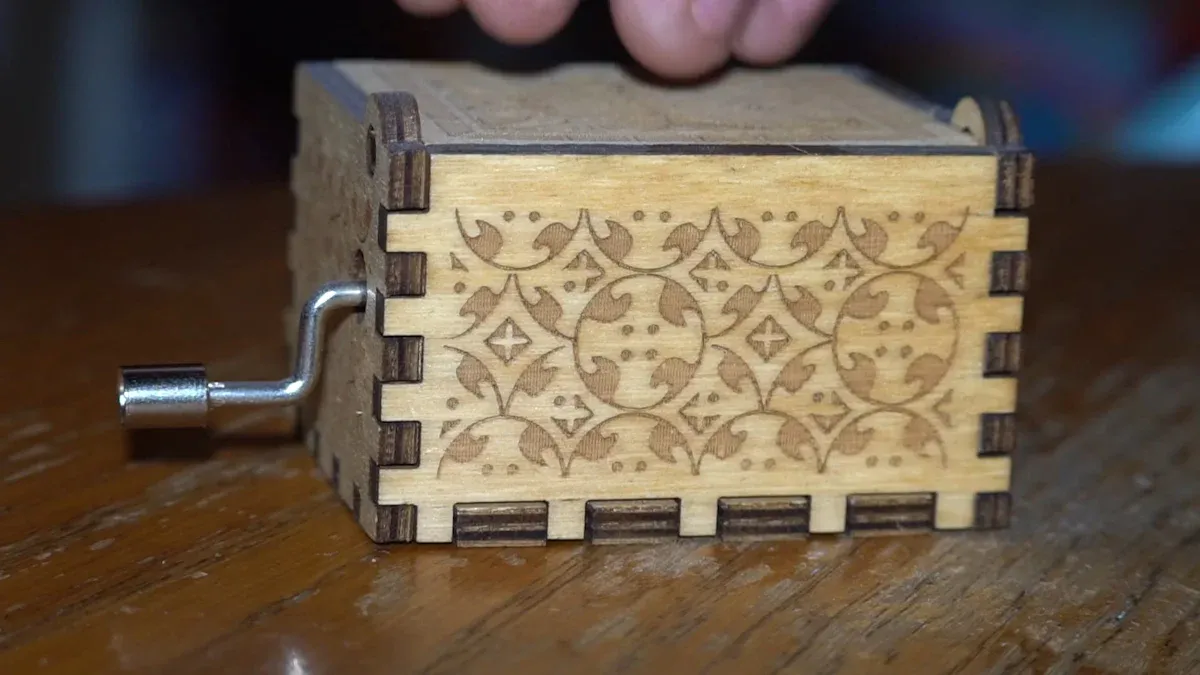
A carved music box captures attention with its intricate details and harmonious melodies. Skilled artisans spend months crafting each piece, combining musical expertise with advanced techniques. Whether given as a wedding gift music box, displayed as a wooden Christmas music box, or enjoyed as a wooden toy carousel music box, every wood custom music box reflects luxury and tradition.
Key Takeaways
- Carved music boxes began in the early 19th century and evolved from simple musical devices into detailed works of art through skilled craftsmanship and technological advances.
- These music boxes symbolize elegance and emotion, often treasured as family heirlooms and valued by collectors for their beauty, rarity, and rich history.
- Modern artists and manufacturers continue to blend tradition with innovation, keeping carved music boxes relevant in art, culture, and music today.
Origins and Artistic Evolution of the Carved Music Box

Early Inventions and the Birth of the Carved Music Box
The story of the carved music box begins in the early 19th century. In 1811, craftsmen in Sainte-Croix, Switzerland, produced the first documented music boxes. These early models did not feature elaborate carvings, but they set the foundation for future artistic developments. Swiss companies, such as Reuge, played a major role in shaping the music box industry. Over time, these makers introduced wood carving and inlay techniques, transforming simple musical devices into decorative treasures. As the demand for more ornate designs grew, artisans in Switzerland began to add intricate details to each box, making every carved music box a unique work of art.
Several inventors and craftsmen contributed to the rise of the carved music box in the United States during the late 19th and early 20th centuries.
- Terrell Robinson (T.R.) Goodman, a carpenter from Tennessee, built early music boxes and passed his skills to his family.
- John Pevahouse, also from Tennessee, crafted hundreds of carved music boxes, using wooden pegs and hand-forged nails.
- The Goodman family, including Dee and George Goodman, became known for building and selling these boxes, often marking them with patent dates from the 1880s.
- Henry Steele and Joe Steele continued the tradition into the mid-20th century, making dulcimers and music boxes with similar craftsmanship.
Technological Progress and the Rise of Carved Music Box Designs
The 19th century saw rapid technological progress that changed the design and function of the carved music box. The transition from cylinder to disc mechanisms allowed music boxes to play longer and more varied tunes. Owners could now swap discs or cylinders to enjoy different melodies. The Industrial Revolution brought steam-powered machines, which made large-scale manufacturing possible. This reduced costs and made music boxes more accessible to families around the world.
Swiss watchmaking expertise improved the sound quality and mechanical precision of music boxes. Makers began to use precious materials and add elaborate engravings, turning each carved music box into a symbol of status and taste. Innovations such as musical automata and coin-operated models expanded the appeal of music boxes, making them popular in both homes and public spaces.
Note: The introduction of new materials changed both the look and function of the carved music box. The table below shows how different materials impacted these musical treasures.
| Material | Aesthetic Impact | Functional Impact |
|---|---|---|
| Wood | Classic, warm, natural look; elegant finish options | Less durable; requires maintenance; sensitive to moisture and temperature |
| Metal | Modern, sleek, robust appearance | Highly durable; suitable for harsh environments; heavier and more expensive |
| Plastic | Versatile in color and design; lightweight | Cost-effective; easy to manufacture; less durable and less aesthetically rich compared to wood or metal |
Ningbo Yunsheng Musical Movement Manufacturing Co., Ltd. continues this tradition today by combining advanced technology with artistic design. The company produces music boxes that reflect both classic craftsmanship and modern innovation.
The Golden Age of the Carved Music Box
The 19th century is often called the Golden Age of the carved music box. During this period, makers produced music boxes in many sizes and shapes, from small pocket models to large cabinets. Mechanical improvements, such as larger cylinders and more pins, allowed for richer melodies and more complex tunes. Artisans decorated these boxes with detailed carvings and inlays, turning them into luxury items for collectors and music lovers.
The combination of technical skill and artistic vision made the carved music box a symbol of refinement. People treasured these objects not only for their music but also for their beauty. The legacy of this era lives on in the work of modern companies and artisans who continue to create music boxes that blend tradition with innovation.
Cultural Significance and Modern Legacy of the Carved Music Box

Carved Music Box as a Symbol of Refinement and Sentiment
Throughout history, the carved music box has stood as a symbol of elegance and emotional connection. People often associate these objects with important life events, such as weddings, anniversaries, and holidays. The detailed carvings and melodies evoke memories and create a sense of nostalgia. Many families pass down music boxes as treasured heirlooms, linking generations through shared experiences.
Collectors and art lovers value the carved music box for its craftsmanship and sentimental value. The intricate designs and careful construction reflect a dedication to beauty and tradition. In modern times, artists continue to use music boxes to express themes of home, memory, and personal identity. For example, Catherine Grisez’s installation, “Constructing Deconstruction,” features 200 music box sculptures. Each steel cube contains a bronze bird-themed key and tells a unique story about the concept of home. Visitors interact with the boxes, turning keys to reveal music and interior details. This installation highlights how the carved music box remains a powerful symbol of both refinement and deep emotion.
Collecting and Preserving the Carved Music Box Today
The world of music box collecting thrives due to the passion of enthusiasts and the support of dedicated organizations. Many societies and museums help collectors preserve and restore these mechanical treasures. Some of the most active groups include:
- AMICA (Automatic Musical Instrument Collectors’ Association), which offers a forum for collectors and preservationists.
- Musical Box Society International (MBSI), serving enthusiasts worldwide.
- Musical Box Society of Great Britain, supporting collectors in the UK.
- International Association of Mechanical Music Preservationists (IAMMP), focusing on preservation.
- Museums such as the Bayernhof Museum, Herschell Carousel Factory Museum, and Morris Museum, which display and care for historic music boxes.
- Online resources like Mechanical Music Digest and Mechanical Music Radio, which connect collectors and share knowledge.
- Restoration experts, such as Bob Yorburg, who specialize in carved music box repair and conservation.
Collectors often seek rare and valuable pieces. The table below shows some of the most notable carved music boxes sold at auction and the factors that contribute to their high value:
| Music Box Model | Auction Price (USD) | Maker/Origin | Notable Features and Factors Contributing to Value |
|---|---|---|---|
| Mermod Frères Cylinder Music Box | $128,500 | Mermod Frères, Switzerland | Rare antique station cylinder music box, inlaid burl walnut cabinet, automaton butterfly and dancing maidens, exquisite craftsmanship |
| Charles Bruguier Oiseau Chantant Box | $72,500 | Charles Bruguier, Switzerland | Crafted entirely from tortoiseshell, early Swiss automaton singing bird box, historical maker family from 1700s-1800s |
One of the highest auction prices ever recorded was for a Hupfeld Super Pan Model III Pan Orchestra, which sold for $495,000 in 2012. Factors such as rarity, age, mechanical complexity, and the use of fine materials like exotic woods and metals drive the value of these music boxes. The nostalgia and fascination with mechanical music also play a key role in their desirability.
Ningbo Yunsheng Musical Movement Manufacturing Co., Ltd. continues to support collectors and enthusiasts by producing high-quality music boxes that blend traditional artistry with modern technology. Their commitment to craftsmanship ensures that the legacy of the carved music box endures for future generations.
The Enduring Influence of the Carved Music Box in Contemporary Art
Artists and musicians today find new ways to use the carved music box in multimedia and interactive projects. These objects serve as both sound sources and visual inspiration. For example, artist Craig Harris uses miniature piano music boxes in his “Music Box Variations” series. He alters the pins and swaps components to create new melodies and soundscapes. These transformed sounds become part of immersive performances, such as the dance theater production “Sleeping Beauty.” In this show, processed music box sounds help tell the story of a character awakening in a modern museum.
Recent installations, like Catherine Grisez’s “Constructing Deconstruction,” place carved music boxes at the center of interactive art. Visitors engage with the boxes, discovering music and stories hidden inside. The installation explores themes of home, acceptance, and personal experience, using the music box as a bridge between tradition and innovation.
Tip: Carved music boxes continue to inspire artists because they combine familiar mechanical sounds with endless creative possibilities. Their presence in modern art shows that these objects remain relevant and meaningful.
The carved music box stands as a link between the past and present. It connects traditional craftsmanship with new artistic expressions, ensuring its place in both cultural history and contemporary creativity.
A carved music box stands as a lasting symbol of artistry and emotion. Collectors value its detailed design and rich history. Each piece tells a story. Families treasure these boxes for generations. The carved music box continues to inspire and connect people across time.
FAQ
What makes a carved music box valuable to collectors?
Collectors value carved music boxes for their craftsmanship, rarity, age, and unique design. Boxes with original mechanisms and detailed carvings often command higher prices.
How should someone care for a carved music box?
Owners should keep music boxes away from moisture and direct sunlight. Regular dusting with a soft cloth helps preserve the wood and carvings.
Can modern artists create custom carved music boxes?
Yes. Many contemporary artists design custom carved music boxes. They use both traditional hand-carving and modern technology to create unique, personalized pieces.
Tip: Always consult a restoration expert before attempting repairs on antique music boxes.
Post time: Jul-22-2025
